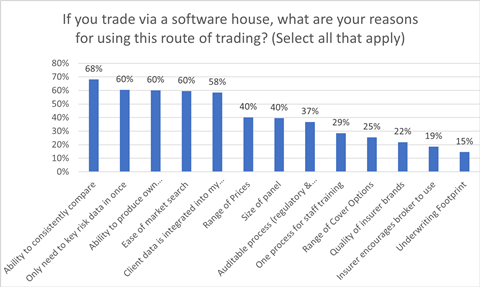With technology constantly evolving, Insurance Times takes a deep dive into the pros and cons of both insurer extranets and software house broker management systems
While every major insurer has its own extranet portal, the benefits of choosing to trade via a software house’s broker management system (BMS) are significant.
The top four reasons brokers gave for using a BMS, range from the ability to consistently compare information (68%), keying in data once (60%), the ability to produce their own documents on their own system (60%) and the ease of conducting a market search (60%), according to Insurance Times’ latest Five Star Rating Report: eTrading 2021, which polled 850 brokers.
The research also revealed that 48% of brokers believe that both etrading routes, extranets and broker management systems, will remain dominant in the near future, up from 40% of respondents who thought this in 2020.
Furthermore, 39% of the survey’s respondents think that broker management systems will be the most dominant route for brokers to use for etrading over the next three to five years, while only 12% feel the same way about insurer extranets.

Despite these findings, Wayne Jefferson, Applied Systems’ etrading manager, told Insurance Times: “Not all insurer products and MGAs trade on broker management systems. Some MGAs, for example, don’t trade on a BMS, so the broker goes to those extranets for different products and different insurers.”
He added that brokers’ preference for a BMS or extranet could also come down to how tech savvy they are, or whether brokers have purchased a BMS that links correctly with insurers’ systems - if it doesn’t, they may still need to revert to using extranets.
Bridging the gap
But why would brokers use both a BMS and insurer extranets?
Simon Bloomfield, head of imarket at Polaris, explained: “Brokers who have a clear SME strategy typically use their system for volume classes and will step outside their system usually only for unusual or niche risks. The operational efficiency and consistency can be a major boost to a broker trading SME business.”
Whether brokers opt for a BMS or trade via extranets can depend on their digital trading strategy too, as well as the availability of products, added Julie Tongue, Allianz’s digital trading manager.
Speaking from an insurer perspective, Tongue said that Allianz supports both approaches.
In terms of bridging the gap between broker management systems and extranets, Jefferson added: “What we do is try to manage that process better by hooking into the insurers’ most up to date products on there.
”That means our brokers are getting access to the most up to date products and prices [as well as] any benefits that an insurer offers straight away. Amalgamation in entirety might be a step too far, but we are doing our best to bridge that process.”
Jefferson said that all software houses use the same question set for certain types of risks. Therefore, using software houses’ broker management systems can save brokers time as data doesn’t need to be rekeyed. This can also reduce error and omission risks and enable brokers to trade more consistently, Jefferson noted.
“Usually if the product is available through the software house, the broker will use those because it manages their time so much better,” he continued. “We manage the whole process for a broker – accounts, reports, claims.”

Meanwhile, using an extranet means brokers need an individual login for each one and have to get to grips with different extranet processes. Obtaining quotes can also be more time consuming because these have to be gathered individually via each insurer extranet.
For Toby MacLachlan, managing director of Ignite Insurance Systems, extranets have their uses - such as for placing small amounts of business.
However, he recommended that brokers invest in a BMS once they have achieved scale. Tongue added that using a BMS can present a single view of the customer.
Broker software house challenges
The biggest challenge for software houses, however, is persuading brokers that their commercial proposition provides operational efficiency and meets customer needs, said Bloomfield.
For MacLachlan, software houses’ biggest challenge is the perception that legacy systems are hard to move away from.
He continued: “The other massive challenge is that insurers are highly risk averse in embracing new software houses and technology, concerned about the cost, complexity and possible disruption of a move [or] a migration.”
Despite most insurer systems being cloud-based, which typically aids integration, MacLachlan noted that cost is still the main barrier here.
Stephen Murphy, director of customer success at Applied Systems Europe, believes the biggest challenge for software houses is the shifting insurance landscape, as well as accommodating technology driven customer expectations.
“The challenge is on the software house to provide these same experiences and continue to deliver them as they change over time,” he added.

For Bloomfield, brokers using software houses also face concerns around the fair presentation of risk products and question sets on broker systems not being in full alignment with these - therefore brokers have to be more vigilant in some cases.
“As standards change, it is also key for brokers to ensure that any additional, mandatory data is collected from customers to ensure they continue to effectively reflect the customer’s risk to insurers,” he added.
Although Bloomfield deemed extranets simpler to use due to reduced question sets that are in alignment with the available products, like Jefferson, he agreed that these are not currently integrated into broker management systems.
For brokers, Murphy said the biggest challenge is “traditional insurance has been made in a one-size-fits-all mentality”.
He added: “Brokers want the ability to integrate other technologies into their broker management system so they can build their own technology stack that works for their specific business needs.”
Constantly innovating
For Peter Goodman, Aventus’ chief executive, “brokers that are ahead of the game today are using technology smartly to free their people up to do what they do best”.
He explained that to get new products to market quickly and efficiently, the following would need to be addressed:
- Affordable digital transformation.
- Automation of repetitive tasks.
- Intelligent use of internal and external data enrichment to raise the bar on the customer journey and experience.
- Increased customer self-service.
- Improved transparency and ease of access.
- Business intelligence and management insights that are accurate, clear, actionable and support capacity strategies.
Goodman argued that broker software platforms need to “put rating, pricing engines and customer journeys firmly in the hands of brokers’ business teams”.
Meanwhile, Murphy thinks the insurance landscape and customer expectations are always changing quickly.
He said: “In order to keep up the pace of innovation, Applied recently moved to [a] more rapid release cycle. Rather than annual product releases with many critical updates, we are delivering smaller, more frequent releases so that brokers can realise value and optimise their systems more quickly.”
Applied expands Google partnership
In February this year, Applied Systems expanded its partnership with Google, adopting additional Google Cloud technologies to extend Applied’s product portfolio and open Applied Epic - the software company’s cloud-based application for independent insurance agencies.
Stephen Murphy, director of customer success at Applied Systems Europe, said: “This new partnership will enable Applied to further expand [its] open application programming interface (API) technology and deliver technologies like data lakes, browser-native applications, artificial intelligence and drive architecture accessibility, speed to market and simpler customer experiences.”
For brokers, these technologies can support increased productivity through simpler user experiences and workflows because they can better connect their technology to other applications, customer portals and insurer applications, according to Murphy.
He said: “To keep up with this fast-changing market, Applied is using its partnership with Google to enhance its product portfolio with access to Google’s forward-thinking people, expertise and culture.”
Applied has already begun rolling out these updates - the most recent being in its customer portal and mobile app, Applied CSR24.

Hosted by comedian and actor Tom Allen, 34 Gold, 23 Silver and 22 Bronze awards were handed out across an amazing 34 categories recognising brilliance and innovation right across the breadth of UK general insurance.



















































No comments yet